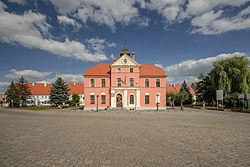Gmina Lewin Brzeski Postal code 49-340 Population 5,940 (2011) Local time Thursday 4:23 PM | Elevation 145 m (476 ft) Area 10.35 km² | |
 | ||
Weather 11°C, Wind NW at 18 km/h, 48% Humidity | ||
Lewin brzeski 2016 nasze miasto
Lewin Brzeski [ˈlɛvʲin ˈbʐɛskʲi] (German: Löwen) is a town in Brzeg County, Opole Voivodeship, Poland, with 5,843 inhabitants (2004).
Contents
- Lewin brzeski 2016 nasze miasto
- Map of Lewin Brzeski Poland
- Lewin brzeski po ar 26 06 2016
- History
- Coat of Arms
- Demography
- Economy
- Transport
- Famous people
- References
Map of Lewin Brzeski, Poland
Lewin brzeski po ar 26 06 2016
History
Located along the medieval trade routes from Silesia to Hungary, by the Amber Road and the Nysa Kłodzka, the town of Lewin first grew up in the Middle Ages as a market town. It is first mentioned in a contract from 1257, when a monastery run by the Knights Hospitaller in Łosiów purchased a mill near the town. It was also mentioned by the moneylender Walter von Lewin that the dukes of Opole. As early as the mid-13th century the city had received Magdeburg Rights, a type of German town law that granted the town a certain amount of autonomy. The town was built around a rectangular marketplace, and surrounded by a rampart with a palisade with a ditch below it that could, if necessary, through the opening of a lock could be filled with water from the Neisse. In addition, there were four city gates. In 1333 the town was granted new rights and privileges, such as the brewing of beer and the holding of Wednesday markets, by Duke Boguslaus of Brieg, as Lewin switched between the duchies of Liegnitz and Brieg and, both of which had already by 1329 come under the suzerainty of the Bohemian crown.
The 16th century brought an economic boom to the city. In 1526 the city passed to the Habsburgs, and since 1592 yearly fairs were organized with the permission of the duke of Brieg. After the Reformation Löwen became mainly Protestant, and the Catholic parish was disbanded. During the Thirty Years War the town was looted, burned, and struck by the Plague. In 1742 Löwen became part of Prussia, by then a town of almost 700 people. Several town fires burned the city, the most devastating in 1829, which destroyed the wooden buildings completely and ushered in a fundamental reconstruction of the city. The city was rebuilt with stone buildings, such as the neoclassical Town Hall built in 1837 on the Ring.
In 1846 Löwen was attached to the Breslau-Oppeln rail line, which brought a revival of industry to the city. In 1866 a metal factory was founded, which produced at first agricultural equipment, then screws, and, much later, finally tape recorders. Other industries included a brick factory, a roof and floor tile factory and a mill. In 1866 the Catholic parish was reestablished, though the St. Mary's Church was not built until the early 20th century. In 1901 the village of Fröbeln, which had a sugar factory since 1882 and population of 554 inhabitants in 1885. Administratively, Löwen was located in Landkreis Brieg, and the seat of its own local court. The old, dilapidated bridge over the Neisse was replaced in 1913 by a new steel bridge.
On 4 February 1945 the town was overtaken by the Red Army. After the expulsion of the German population the town was transferred to Polish control and renamed Lewin Brzeski, which was first administered as part of Wroclaw Voivodship. In 1950 the city was moved to Opole Voivodship, where it has remained despite the administrative reforms of 1999.
Coat of Arms
The coat of arms of Lewin was adopted on 18 June 1998 and was based on a seal from the year 1333. It shows a golden lion bordered by three hills on a blue background. The lion recalls the old German name Löwen, which means "lions".
Demography
Economy
Lewin Brzeski's economy is in large dependent on the local agricultural sector. The largest industry in the locality is the sugar mill "Wróblin". Surrounding the town there are five former gravel pits, now infilled by water, are a popular attraction for locals and people in the region alike. The town and its vicinity is home to numerous tourist attractions.
Transport
Lewin Brzeski is located on the Voivodeship Road (northbound to Skorogoszcz and the National Road ; southbound towards Przylesie, where the road joins the Voivodeship Road , northbound towards Brzeg and southbound towards the A4 Motorway then on). The interchange to the Motorway (Węzeł Przylesie) is located 20 km west of Lewin Brzeski.
Lewin Brzeski lies on the main railway artery between Wrocław and Katowice/Lubliniec.
